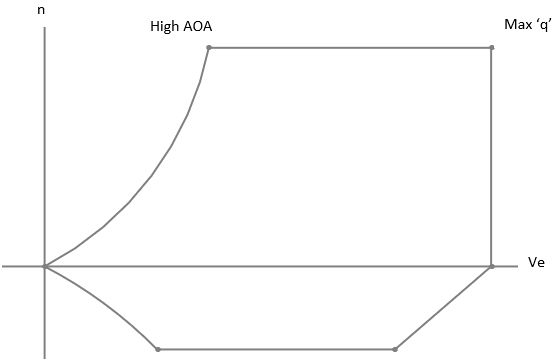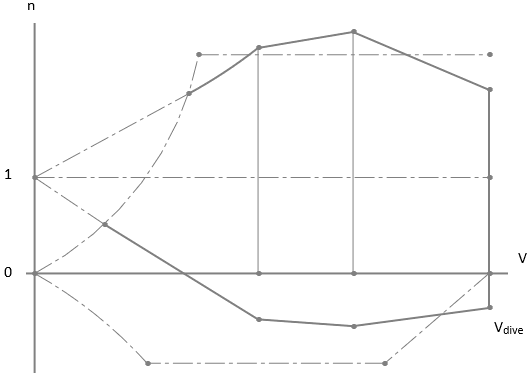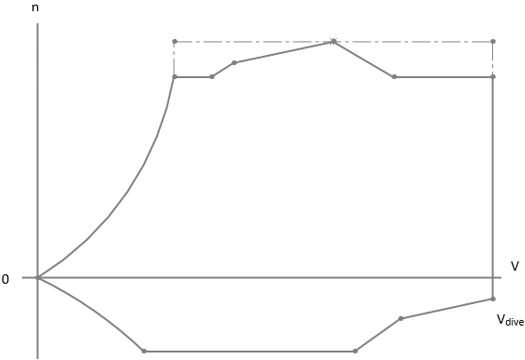This set of Aircraft Design Multiple Choice Questions & Answers (MCQs) focuses on “Air Loads”.
1. Load factor is defined as _______________
a) ratio of lift produced to the weight of aircraft
b) aerodynamic efficiency
c) thrust loading
d) power to weight ratio
View Answer
Explanation: Load factor is defined as the ratio of lift produced and the weight of the aircraft. For cruising flight lift is equal to weight. Hence, at such flight condition load factor is unity. Aerodynamic efficiency is defined as ratio of lift to drag. It is directly affected by aerodynamics of the aircraft. Thrust loading is ratio of thrust to weight ratio.
2. Following diagram represents _________

a) maneuver v-n diagram
b) drag polar
c) load factor vs drag
d) thrust required graph
View Answer
Explanation: Above diagram represents a typical Maneuver characteristics. A typical Maneuver V-N diagram is shown in the above diagram. Drag polar is graphical representation of the aircraft drag properties. Typically it is used to show drag variation. Thrust required is used to oppose the drag produced.
3. An aircraft is cruising with lift of 150N. Find the weight of aircraft.
a) 0.150KN
b) 150KN
c) 123N
d) 15KN
View Answer
Explanation: At cruise, Weight W = Lift = 150N = 0.150KN.
4. The dive speed in v-n diagram represents _________
a) maximum dynamic pressure
b) maximum manifold pressure of supercharger
c) hydraulic actuator speed limit
d) rate of climb
View Answer
Explanation: Maximum dynamic pressure is being represented by the dive speed in a typical V-n diagram. Manifold pressure at intake is almost equal to the atmospheric. Supercharger is used to increase manifold pressure by large amounts. Rage of climb is vertical velocity.
5. A typical aircraft has level cruise speed of 0.6M. Find the dive speed for given subsonic aircraft.
a) 0.9M
b) 1.9M
c) 330m/s
d) 345m/s
View Answer
Explanation: Dive speed = cruise speed + 0.5*cruise speed
= 0.6 + 0.5*0.6 = 0.9M.
6. If actual speed of aircraft is 100 m/s and is flying at certain altitude with density ratio of 0.3 then, find equivalent at speed at that altitude.
a) 54.77m/s
b) 125ft/s2
c) 1.2M
d) 1.5M
View Answer
Explanation: Equivalent airspeed = actual speed * (Density ratio)0.5
= 100*(0.30.5) = 54.77 m/s.
7. My aircraft is flying at particular altitude. At that altitude ratio of actual airspeed to the equivalent airspeed is 1.4 then, what should be the desire value of density ratio?
a) 0.51
b) 1.89
c) 0.12
d) 0.189
View Answer
Explanation: Density ratio = (1/ratio of actual airspeed and Equivalent airspeed)2
= (1/1.4)2 = 0.51.
8. An aircraft is cruising with cruise speed of 250m/s. All of the sudden aircraft experiences in a gust with velocity of 10m/s. determine the change in angle of attack due to this upward gust.
a) ∼2.3°
b) ∼6°
c) ∼5.6°
d) 9°
View Answer
Explanation: Change in AOA = arctan (gust velocity / cruise speed)
= arctan (10/250)
= arctan 0.04 = 2.29 ∼ 2.3 deg.
9. Following diagram represents __________

a) gust V-n diagram
b) maneuver diagram only
c) load factor variation with thrust
d) drag polar
View Answer
Explanation: A typical gust V-n diagram is shown in the above diagram. Here, in this V-n diagram we are assuming that the aircraft is experiencing gust at 1g. Maneuver V-N diagram is different from the gust diagram. Drag polar is used to relate drag and lift.
10. Following diagram represents ___________

a) v-n diagram combined of gust and Maneuver
b) v-n diagram landing
c) takeoff speed
d) drag coefficient vs lift
View Answer
Explanation: Above diagram is illustrating a typical V-n diagram. Above diagram is a typical combined V-n diagram of gust and Maneuver. Drag coefficient vs lift coefficient graph is nothing but the drag polar. Takeoff speed is based on takeoff loads.
11. When an aircraft flies in air, it experiences _________
a) lift, drag, thrust loads, etc
b) only lift load
c) only gust load
d) only drag force
View Answer
Explanation: When an aircraft flies in the air, it might experience various types of loads such as lift, drag Thrust, vibration, gust etc. Only single load cannot be experienced in real life. At a time there will be number of loads acting on the aircraft during flight.
12. When aircraft is in air, it can only experience air load.
a) True
b) False
View Answer
Explanation: No, it is not true. In the air, it is not only experiencing the air loads rather an aircraft will experience number of different types of loads. For example, lift, drag etc. are air loads however Thrust force is a power plant load which is experienced by aircraft during flight in air. Hence, the given statement is not true.
Sanfoundry Global Education & Learning Series – Aircraft Design.
To practice all areas of Aircraft Design, here is complete set of 1000+ Multiple Choice Questions and Answers.
If you find a mistake in question / option / answer, kindly take a screenshot and email to [email protected]
- Practice Aerospace Engineering MCQs
- Practice Aeronautical Engineering MCQs
- Check Aircraft Design Books
- Apply for Aerospace Engineering Internship
- Check Aerospace Engineering Books
